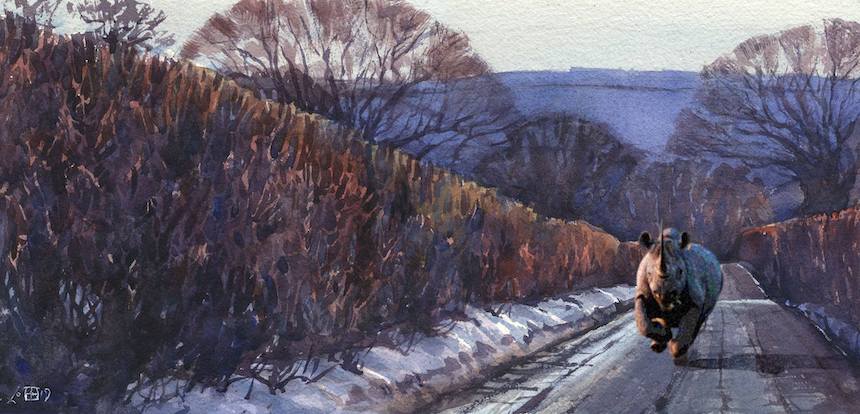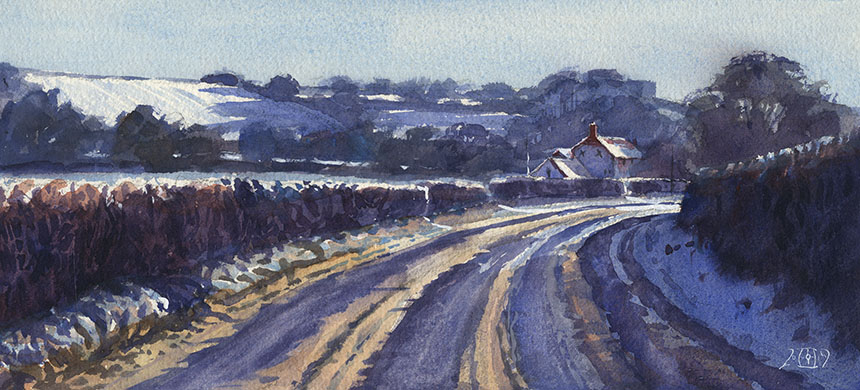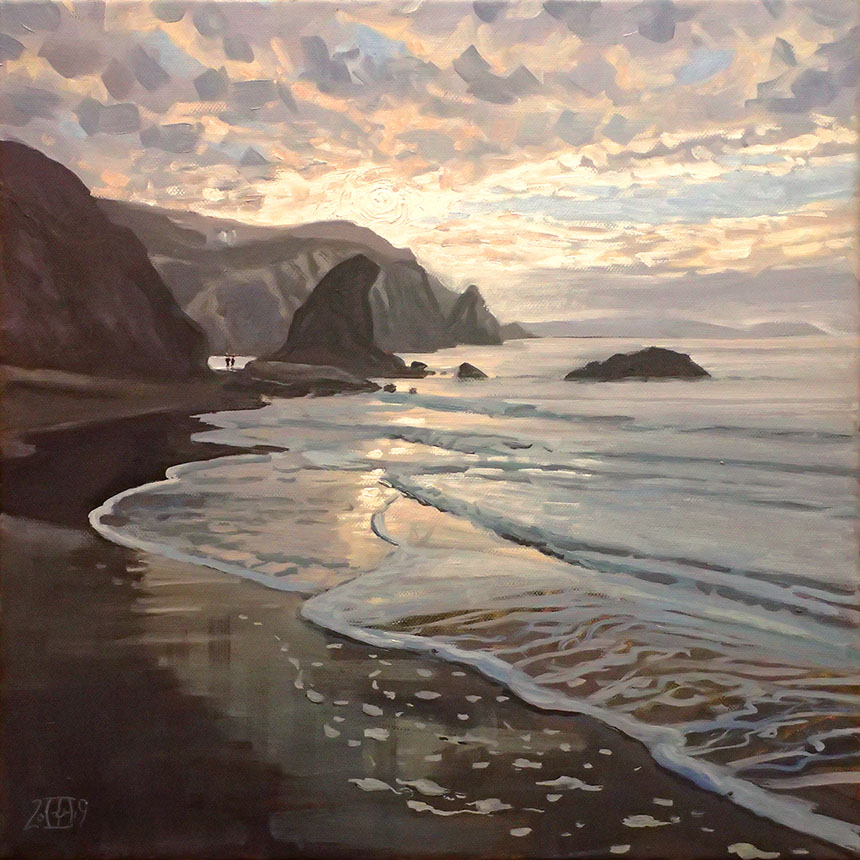Narrative content used to be a de-facto part of a painting. From biblical scenes to Ukiyo-e in Japan, even back to mammoth hunts on cave walls. Stanley Spencer, moments of moral tension in Victorian art, glimpses of sensual frivolity in France and everyday life in Holland. All these to some degree have narrative content at their core. Narrative content has fallen from fashion though. Even from the time of Claude Lorraine and later Turner you can see the narrative content withering. With the Impressionists it is there with the cafe scenes, but gone in many of the landscapes.
It has had a longer life in the niche of surrealism, naive and mystical painting. Illustration of course nearly always narrative in intent. The modern fad for formalism has mostly washed away desire to tell a story from the admissible ambitions of today’s painters. It is the the painting itself rather than any story it might tell that is the important factor to artists. This is of course not true of the viewers of paintings, who still love a story. It is just that artists feel that they are above such menial tasks and serve a higher and more elevated muse.
The result of this conundrum is a little perplexing, the fine art world is awash with artists who want to address important, serious and relevant issues, but are alas denied by fashion most of the tools by which they might do so. To have any chance of smuggling narrative work into the fine art arena you must have a quirk such as painting your cartoons on walls as Banksy does, being an international man of mystery helps too. Hogarth could comment on social issues in a direct manner in his work, but today’s painters do not have that option if they want to be accepted into the gated community of the contemporary art establishment. Some, like Paula Rego, sneak in under the cover of magical realism, but mostly the doors are firmly barred.
This subject was partly brought top mind by the reviews of Sorolla at the National Gallery. The reviewers only seemed to be able to comment on the content. They did not seem to see the abstract qualities of the paintings, they could not get past the narrative. Which shows I suppose how powerful an element it is.
So what is narrative and how do we exploit it? Like all the ingredients that can make up a picture we can add more or less to taste, or indeed none at all.
The smallest doses of narrative are signs of past activity or impending activity, either natural or human. So the hay bales in a field tell us of activity even though the farmer is not in view. A war painting might show destruction but no soldiers, merely the aftermath. The purple threatening clouds might hint at an oncoming storm. The unifying ingredient here is the passage of time, we are alluding to time before and after the moment in the painting.
To the other extreme we might have a comic strip where the whole image is narrative driven with the flow of time and even words and thoughts are included. The Sistine ceiling is another example of dominant narrative. All the other elements of painting are there, but their purpose is to serve the narrative.
So if your landscape painting has a dog walker it is quite different in mood to one where the scene is empty. The viewer’s eye will home in on the figure. If it is a figure on a wild moor we will ascribe loneliness, isolation or some other poetic notion. If we have two figures apart we might ascribe emotional separation too. If close then companionship, if arm in arm perhaps love. A group of three might indicate family. When we see isolated figures we cannot help but to attempt to decode social clues.
Interestingly if we have a crowd or a group of five or so then that reduces the narrative draw. If in a painting in a city square you have groups of inhabitants then the eye will be drawn to any single figures. Any people in groups are assessed as composite beings not necessarily individuals. If we bring our group forward and make the painting about them the a whole other set of narrative considerations come in to play. We immediately set too and try and assess the relationships between them.
If we have a single figure and slowly enlarge or refine it the composition, then at a certain point we attempt to determine the emotional state. There used to be manuals for artists about how to paint different emotions, which to our eyes look comically theatrical. If the figure has no clear emotion then it can attract more consideration than if overtly weeping or laughing. This is simply because the viewer has to work harder and is therefore more deeply engaged.
So narrative elements are powerful tools and not easy to use. They also are very prone to the whims of fashion. We find Victorian morality paintings heavy handed and crass, but at the time they were thought to be the bee’s knees. Care must be taken when adding incidental figures, you quite often see urban scenes where all the figures are individual, each a separate observation. Oddly this nearly always detracts from the unity of the overall scene, or gives the the feeling of a montage. I have seen crowd paintings where all the figures look like the moment just before the zombies in Thriller begin to dance!
Time to catch up with the watercolours…
I am so behind with blogging that this was last year! This was a whistle stop visit to Arundel. I was very rushed so didn’t do the place justice. I will return as it has some fascinating things to paint. 12in by 6in Watercolour.
I took a bit longer over this but still only about 30min before I had to leave Arundel behind. 12in by 7.5in Watercolour.
This is Pulpit Rock on Portland Bill, a studio painting which I did entirely with a 1in sable flat. More of an experiment than a finished work but fun to do. I notice by the date I have ignored the watercolours for nearly 8 months. 12in by 12in Watercolour.
This is a great view of Hambledon Hill from Bedchester. I really must do it in better light but have been unlucky so far. the scene is good in any light but that just means it would be better still on another day. 12in by 6in Watercolour.
This is another scene that has been frustrating me, but this time I was there at just the right moment. Slightly tricky as to make a decent composition you have to move Hambledon Hill about 300m West. No one complained as I put it back once I was done. Here the challenge was to get the brilliant winter light. To this end everything had to be made subservient to the reflected light in the road. 10in by 7in Watercolour.
A quick impression of Shaftesbury, didn’t want to get into too much detail as the shadow was the main event. Painted all with a flat brush again. No time to preserve all the lights so a few touches of opaque paint to annoy the purists! 8in by 6in Watercolour.
This is the River Stour from the bridge at Blandford. The willow has wonderful colour this time of year. Not perfect light as I was a bit late, I must manage to catch it in perfect light. Unfortunately the bridge is too narrow for plein air, I am happy to suffer for my art, but dying is going to far! 14in by 7in watercolour.
Snow! On the day I stuck to the oils but I had so many atmospheric snaps taken as we drove around I could not resist a couple of studio efforts. The studio is great for this sort of painting as you can leave the washes to dry and preserve all your lights. This is near Bulbarrow. 14in by 7in.
Last one this is the road as it drops off Bulbarrow. The snow bounces the light around and makes some wonderful contrasts. I thought this was a good image to show what adding a narrative element does. 12in by 6in Watercolour.

So if you hung these two versions side by side which would get commented on? Does the fact that the Rhino would draw attention make this a better painting? Or does the Rhino get in the way of appreciating the mood of the scene? Not questions I have answers to, but they are questions a painter needs to consider and it shows just how powerful narrative elements are.


















